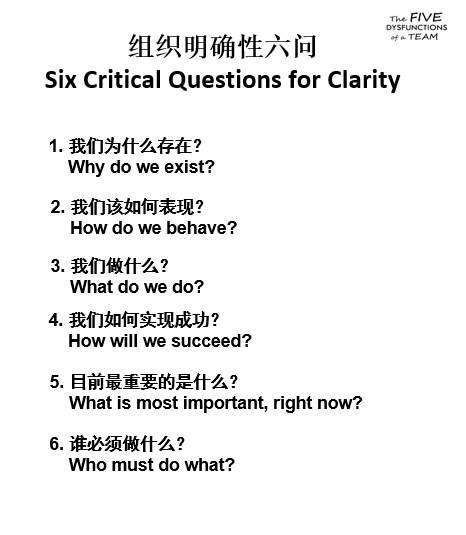The Four Disciplines Model 健康组织的四项纪律 - 摘译自《优势》组织健康胜于一切
An organization doesn't become healthy in a linear, tidy fashion. Like building a strong marriage or family, it's a messy process that involves doing a few things at once, and it must be maintained on an ongoing basis in order to be preserved. Still, that messy process can be broken down into four simple disciplines。
打造一个健康的组织不是以线性和齐整的方式进行的。就像建立一个很强的婚姻或家庭一样,它是一个混乱的过程。它涉及同时做几件事情,但必须一直不断地维护并持续保持。 尽管如此,这个混乱的过程可以分解为四项简单的纪律。
DISCIPLINE 1: BUILD A COHESIVE LEADERSHIP TEAM 纪律1:建立一个富有凝聚力的领导团队
An organization simply cannot be healthy if the people who are chartered with running it are not behaviorally cohesive in five fundamental ways. In any kind of organization, from a corporation to a department within that corporation,from a small entrepreneurial company to a church or a school, dysfunction and lack of cohesion at the top inevitably lead to a lack of health throughout.
如果一个组织的管理者们在五个基本方面(注,指:团队协作的五大障碍)没有行为上的凝聚,那么组织肯定就不会健康。 在任何类型的组织中,从公司到公司中的部门,从小型企业公司到机构或学校,顶层管理团队功能丧失和缺乏凝聚力不可避免地会导致整个组织的健康不良。
CHECKLIST FOR DISCIPLINE 1-BUILD A COHESIVE LEADERSHIP TEAM 纪律1-建立一个富有凝聚力的领导团队 对照检查表
Members of a leadership team can be confident that they've mastered this discipline when they can affirm the following statements:
- The leadership team is small enough (three to ten people) to be effective.
- Members of the team trust one another and can be genuinely vulnerable with each other.
- Team members regularly engage in productive, unfiltered conflict around important issues.
- The team leaves meetings with clear-cut, active, and specific agreements around decisions.
- Team members hold one another accountable to commitments and behaviors.
- Members of the leadership team are focused on team number one.They put the collective priorities and needs of the larger organization ahead of their own departments.
如果能确认做到下列陈述时,领导团队成员们可以确信已经掌握了这条纪律:
-领导团队人数足够小(三到十人)才能发挥效能。
-团队成员互相信任,彼此间相互真正坦露各自的脆弱点。
-团队成员定期地投身于围绕重要问题上的富有成果、坦露直言的冲突。
-团队结束会议时,对团队的决定达成明确的、积极的,具体的协议。
-团队成员就承诺和行为,互相共担责任。
-领导团队成员专注在第一团队,即把集体的优先及大团队的需求放在他们自己部门之前。
DISCIPLINE 2: CREATE CLARITY 纪律2:建立明晰度
In addition to being behaviorally cohesive, the leadership team of ahealthy organization must be intellectually aligned and committed to the same answers to six simple but critical questions. There can be no daylight between leaders around these fundamental issues.
除了具有行为上凝聚外,健康组织的领导团队必须在认知上保持一致并致力于对六个简单但非常关键的问题(注,指:组织明晰六问)上有相同的解答。在这些基本问题上,领导人之间没有漏缝。
CHECKLIST FOR DISCIPLINE 2: CREATECLARITY 纪律2-建立明晰度对照检查表
Members of a leadership team can be confident that they've masteredthis discipline when they can affirm the following statements
-Members of the leadership team know, agree on, and are passionateabout the reason that the organization exists.
-The leadership team has clarified and embraced a small, specificset of behavioral values.
-Leaders are clear and aligned around a strategy that helps them define success and differentiate from competitors.
-The leadership team has a clear, current goal around which theyrally. They feel a collective sense of ownership for that goal.
-Members of the leadership team understand one another's roles and responsibilities. They are comfortable asking questions about one another's work.
-The elements of the organization's clarity are concisely summarized and regularly referenced and reviewed by the leadership team.
如果能确认做到下列陈述时,领导团队成员们可以确信已经掌握了这条纪律:
- 领导团队成员了解,同意并对组织为什么存在充满热情.
- 领导团队澄清并信奉几个具体的、行为价值观。
- 领导们对战略,清晰并一致,该战略有助于他们定义成功并区别于竞争对手。
- 领导团队有一个清晰的当期目标并团结在此周围。对该目标,他们主人翁感的集体意识。
- 领导团队成员了解彼此的角色和责任。他们乐意对彼此的工作提出问题。
- 组织清晰度的要素由领导团队简明扼要地总结、定期引用并回顾。
DISCIPLINE 3: OVERCOMMUNICATE CLARITY 纪律3:反复沟通明晰度
Once a leadership team has established behavioral cohesion and created clarity around the answers to those questions, it must then communicate those answers to employees clearly, repeatedly, enthusiastically, and repeatedly (that's not a typo). When it comes to reinforcing clarity, there is no such thing as too much communication.
一旦领导团队建立了行为的凝聚并对那些问题的答案建立了明晰度,就必须同员工清楚地,反复热情地,并多次反复地将这些答案传递给员工。为了要加强明晰度,多次沟通也不多。
CHECKLIST FOR DISCIPLINE 3: OVERCOMMUNICATE CLARITY 纪律3-反复沟通明晰度 对照检查表
Members of a leadership team can be confident that they've masteredthis discipline when they can affirm the following statements。
- The leadership team has clearly communicated the six aspects ofclarity to all employees.
- Team members regularly remind the people in their departments about those aspects of clarity。
- The team leaves meetings with clear and specific agreements aboutwhat to communicate to their employees, and they cascade those messages quickly after meetings。
- Employees are able to accurately articulate the organization's reason for existence, values, strategic anchors, and goals.
如果能确认做到下列陈述时,领导团队成员们可以确信已经掌握了这条纪律:
- 领导团队已清楚地向所有员工沟通了明晰度的六个方面。
- 团队成员定期提醒其所在部门的人员有关清晰度这些方面。
- 团队在会议结束前,就与员工沟通达成明确及具体的一致,并在会议后迅速将这些信息逐级传达。
- 员工能够准确地阐明组织的存在理由,价值观,战略锚和目标。
DISCIPLINE 4: REINFORCE CLARITY 纪律4:加强明晰度
Finally, in order for an organization to remain healthy over time, its leaders must establish a few critical, nonbureaucratic systems to reinforce clarity in every process that involves people. Every policy, every program,every activity should be designed to remind employees what is really most important.
最后,为了使组织长期保持健康,领导者们必须建立一些关键的、非官僚的制度,在所有过程中加强明晰度。每项政策,每项计划,每项活动都应成为提醒员工什么是真正最重要的。
CHECKLIST FOR DISCIPLINE 4: REINFORCECLARITY 纪律4-加强明晰度 对照检查表
Members of a leadership team can be confident that they've mastered this discipline when they can affirm the following statements:
-The organization has a simple way to ensure that new hires are carefully selected based on the company's values.
-New people are brought into the organization by thoroughly teaching them about the six elements of clarity.
-Managers throughout the organization have a simple, consistent, and nonbureaucratic system for setting goals and reviewing progress with employees.That system is customized around the elements of clarity.
-Employees who don't fit the values are managed out of the organization. Poor performers who do fit the values are given the coaching and assistance they need to succeed。
-Compensation and reward systems are built around the values and goals of the organization.
如果能确认做到下列陈述时,领导团队成员们可以确信已经掌握了这条纪律:
- 组织有一种简单的方法可以确保根据公司价值观认真挑选新员工。
- 通过彻底培训关于明晰度的六个要素,将新员工带入到组织。
- 整个组织的经理们有一个简单、一致且非官僚的系统,该系统是用来同员工一起设定目标和回顾进度。该系统是围绕明晰度元素定制的。
- 将不符合组织价值观的员工清除出去。对那些符合价值观但绩效不佳的员工,为其获得成功提供所需的指导和帮助。
- 围绕组织的价值观和目标,建立薪酬和奖励系统。
Is this model foolproof? Pretty much. When an organization's leaders are cohesive, when they are unambiguously aligned around a common set of answers to a few critical questions, when they communicate those answers again and again and again, and when they put effective processes in place to reinforce those answers, they create an environment in which success is almost impossible to prevent. Really. Sure, if those leaders make a catastrophic, completely boneheaded mistake in strategy, finance, or marketing they could sink the organization. But people in healthy organizations rarely make those kinds of mistakes. That's because cohesive leadership teams prevent groupthink, learn from mistakes, and call each other on potential problems before they get out of hand. And so it makes sense that this is the first of the four disciplines that should be taken on:building a cohesive leadership team.
这个模型简单明了吗?非常肯定。当一个组织的领导者们具有凝聚力时,当他们明确地围绕一些关键问题有共同答案时,当他们一次又一次地沟通这些答案时,以及当他们实施这些有效的流程来强化这些答案时,他们就创造一个几乎无法阻止成功的环境。真得。的确,如果这些领导者在战略、财务或市场营销方面犯了一个灾难性,十分愚蠢的错误,他们就会毁掉组织。但在健康的组织中,人很少会犯这些错误。这是因为有凝聚力的领导团队可以通过集体思考与学习来防止错误,并在失控前互相提醒潜在的问题。因此,建立一个富有凝聚力的领导团队放在四项纪律中的首位是十分有意义的。


